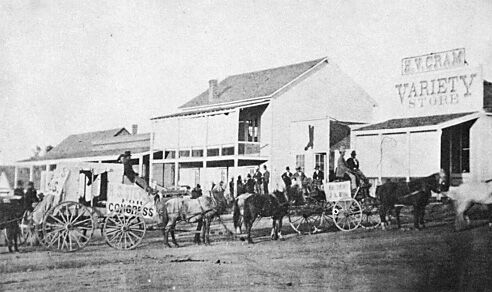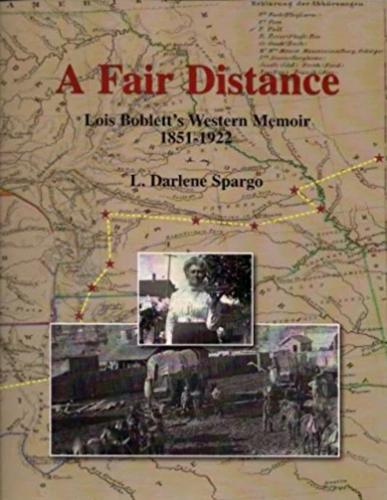Throughout her life, Lois Whitcomb Boblett rarely stayed in one place for long.
When she was born on Feb. 1, 1844, in Milwaukee, her mother was working as a cook at the first hotel in town. By the time Lois was 7 years old, her family was on the move chasing stories of a better life just down the road. They lived in Iowa, Nebraska, and Kansas Territories where Lois met and married gold miner Edward Alexander Boblett in 1860. The following year, Kansas Territory was divided into the territories of Kansas and Colorado.
In March 1864, Lois and Ed, along with Lois’ parents, left Colorado on their way to Arizona. Arriving in Albuquerque, New Mexico, the couple was offered an opportunity to run a hotel and restaurant. They decided to stay since the hotel catered to passengers coming in by stagecoach as well as soldiers traveling through the area — plenty of clientele.
As many as 150 people might file through the doors of the restaurant in a day. Lois and her mother often cooked up to five sheep for the hungry crowd, adding beef and pork to the menu when they could get it. Lois also took on the waitress job.
Charging $1.50 per meal, money poured in and for three months, the Bobletts worked tirelessly.
They had a partner who tended the bar until the day the Bobletts realized the man had stolen all their proceeds. Almost penniless, Lois and Ed left Albuquerque hoping the hills around Prescott would provide better opportunities.
The day after they arrived in Prescott, the couple was approached by a man who asked if they could board nine men who made up the northern delegates of the Arizona Legislature. The southern representatives were housed in the only hotel in town. “(A) fight is on for the capitol,” the man said, “and we want to board where we can talk things over by ourselves.”
The dispute over which city would house the territorial capitol went on for several years with the seat of power moving from Prescott to Tucson and back to Prescott. Not until 1889 was Phoenix selected as the permanent location.

Lois Boblett’s memoir
“We went to work and set our wagon boxes down on the ground and put a ridge pole up between them,” Lois said, “sewed the wagon sheets together and then put the wagon boxes just as far apart as we could and had the sheets up high enough to turn the rain. Then we sewed sheets in the gable ends and that made a dining room. We fixed a place outside to cook and the next day, we started a boarding house in a tent under a big pine tree, with nine of the first legislators that ever met in Arizona.”
Charging $1 for a meal consisting of bacon, bread, and venison if they could get it, the Bobletts stayed in the hotel business only a short while before finding employment at a sawmill — Ed worked in the mill while Lois and her mother cooked for the workers.
In the spring of 1865, Lois and Ed found a plot of land that suited their plans to farm and raise cattle. Settling about 50 miles outside of Prescott, Lois described the area as “a lovely place, being a little elevation above the surrounding country.”
They dug a well, but Lois quickly discovered she could not even cook beans in the water. After soaking and cooking for hours, “they would rattle on our plates as though they had never been cooked at all.”
Lois and her mother put in a garden but in June, Indians drove off their cattle and wounded Lois’ father. When the Indians raided again, the Bobletts returned to Prescott and began another boardinghouse.
Lois and Ed soon outgrew their small hostel and opened a larger one that included a bowling alley and saloon on one end of the building, but trying to keep their boarders safe from unruly drunken brawlers proved difficult.
“One day, two men got in a fight,” Lois said, “and one was beating the other over the head with an iron pin and the other, in trying to get away, burst down the door and came into our part of the house with blood streaming from his head.”
Another time, “they commenced shooting in the saloon and some of the shots came in our part, into the living room, and all of the yelling and smashing of windows I never heard before or since.”
In the spring of 1866, the Bobletts were again on the move, agreeing to maintain a tollgate road about 40 miles from Prescott on the Mohave Road. The family arrived at their new home that became known as Tollgate during the height of the Hualapai War that lasted from 1865 until 1870.
“We got good wages for keeping the gate,” Lois said, “and all we could make off the travel.”
They built a house out of poles covered by a roof of brush and grass, added portholes to watch for approaching Indians, and built another house nearby to accommodate travelers along the route.
“There were soldiers sent out several times to chase the Indians away,” Lois said, “but they would come back every few weeks, so we had to be on our guard at all times.”
In the fall of 1868, a band of Indians killed Lois’ brother. The Bobletts stayed another year before leaving Arizona after five years of hardship and danger. In November 1869, they boarded a train for California and eventually made their way to Washington Territory.
With no regrets on leaving Arizona, Lois remarked their time in the territory was “the worst move we ever made.”
Lois and Ed had no children of their own but took in two orphans while living in Arizona, and later adopted another boy.
Ed died in 1903, followed by Lois in 1925 at age 81. Throughout her life, Lois kept journals of her travels and trials, but her papers have not survived. However, in 1920, Lois narrated her time in Arizona and the early west. Those memoirs, titled “A Fair Distance,” were published in 2009.
How well do you know Arizona? Here is another quiz to test your knowledge on Arizona history and facts. Video by Pascal Albright / Arizona Daily Star





